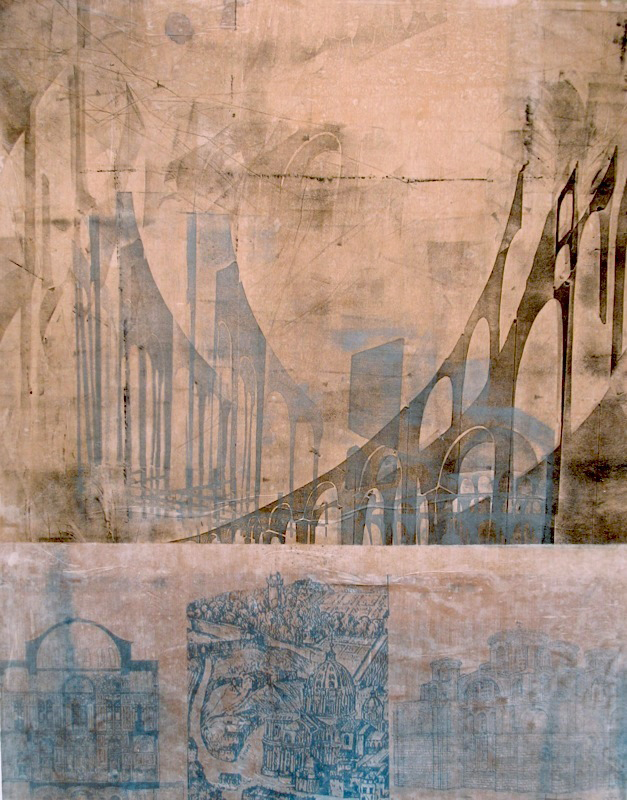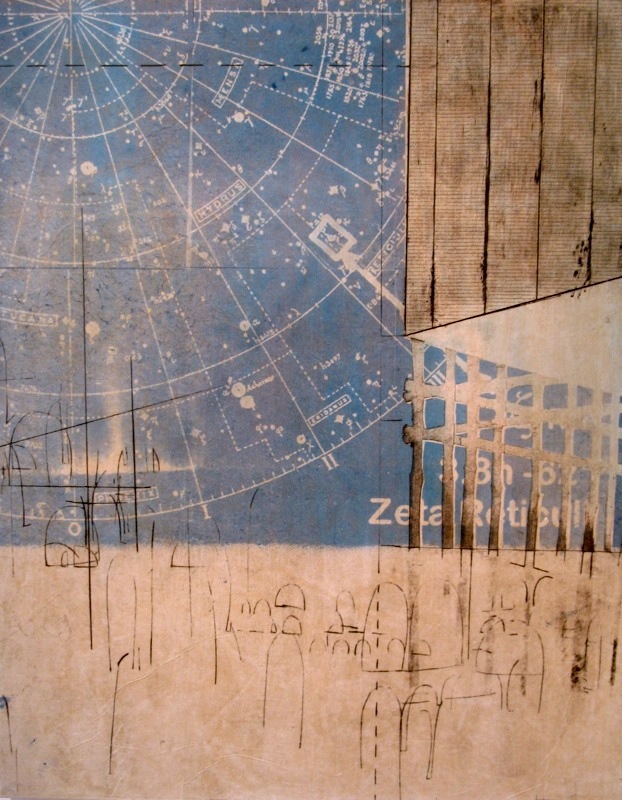In Bret Hanson’s work we are invited into an abstract dream world. However, as the adventure begins we are haunted by a sense of familiarity and the reality that this is neither dream nor abstract. Stuttered in our travel we begin to wonder.
We are lulled into the supposed safety and simplicity of these prints through the subtle colors employed by Bret. At first, lost in the cosmos, we float in the otherworldliness of the work. Mid-flight however, we are grounded by the shapes of human history, called back to earth by the repeated arches and aqueducts of roman architecture. It seems, that every time we begin to float away we are recalled by some wisp of earthly experience. Whether through the structure of architecture, the bird’s eye view of a map, or representations of the stars, we are at once in three spaces: those of the earth, the sky and the heavens but also of the past, the present, and the future.
This is an experience of all-knowing which leads us, the viewers, to question just that.
What inspires us to question our perspective in our world? Why do we question the question that will be asked again and again for all of human history?
Bret Hanson’s work has been greatly affected by his spiritual upbringing and its continuation in his life. He uses mapping and inspiration from his places of worship to give visual cues to this eternal question.
It seems to me that from wherever these questions arise, the drive to find some orientation, to know where you stand is universal.
-Visual Arts Editor, Liz McDonald
 Navigations
Navigations
mixed media print
 Navigations
Navigations
detail
 Installation
Installation

Piranesi’s Dream
mixed media print

Radiant
mixed media print

Interior
mixed media print
Bio:
Bret Hanson
Artist Statement
I was born in Blackfoot, Idaho and raised in a religious home. Both the physical and spiritual landscapes of my youth have an impact on my work. Stars in the night sky, flat farmland, and the Rocky Mountains nearby all helped shape the way I interpret my surroundings. I was fascinated with space and flight and wanted to be a pilot and transcend this world. There has always been a strong sense of striving to return to God’s presence, and navigate through the trials of this life to achieve eternal life.
Religious symbolism plays a prominent role in my thought process as a Mormon artist. Architectural buildings, such as our church house and the temple were also important to me. Temples are adorned with symbols of the cosmos as well as compasses and squares, which symbolize keeping one’s life in order and charting an exact path towards God.
Geometry has been historically tied to spirituality. The Star of David consists of two triangles, one pointing upwards and the other pointing down. This is symbolic of God’s interaction with man and man’s attempt to become more like God. The triangle can also symbolize a mountain, which in turn is a symbol of the Lord’s temple.
Imagery such as star-maps and constellations are used to reference the cosmos as well as ideas of creation and spiritual navigation. The cyanotype technique is used as a visual metaphor for the concepts of design and invention, which include supreme design as well as human beings’ potential for innovation and creation. The blue color of the star chart also reads as the sky, so that the map of the sky becomes the thing for which it is a symbol. The color also references the backgrounds of Byzantine mosaics (and frescos).
Mapping is a prevalent theme in my work. A map is a way to understand the world and what one’s place is in it. It is also a pictorial symbol representing a space beyond itself. In my work I am developing a personal map-making language. By combining architectural and organic elements of places I have seen and/or experienced, a new way to map my mind emerges. I am inventing a new cartography: map-like imagery that consists of simplified elements of my memories, thoughts, and experiences.
These prints are also about spaces. They deal with the idea of implied space in a two-dimensional format, as well as the spaces that we inhabit. All of the elements in the prints are quite flat, yet our minds begin to expand the shapes in an attempt to make sense of the space. In this way the spaces in the prints function as a stage set.
Flat paintings and props employ our imagination to convince our minds of actual spaces. Stage sets are symbolic representations of larger spaces. There is also play between the ideas of negative and positive spaces. Embracing the ironies of positive/negative, and flat/voluminous spaces creates visual tension and interest. Arranging visual elements in this way turns the process of printmaking into a form of collage. Overlapping layers of transparent ink and paper allow me to create content in which the sum of all the parts transcends any of the individual ones, much like the way that tracks are mixed on a musical record. It is a sort of visual alchemy.
While I am creating layers of information that adds to the feeing of depth and substance, I am also intrigued with the effects of dematerialization of form. I am trying to capture the essence, or spiritual quality of things that appears when forms are stripped back to the most basic elements. Diagrammatic lines and map-like imagery help to give this work a universal quality as well.
In this work, I have been striving to create a new mapping system, a way to synthesize map-like language into visual record of my life. By extracting certain lines and shapes from maps and architecture, I can reference both of those worlds, but fragment them enough so that the result is that of a more personal mapping language. The fragmentation of imagery also adds to the content as a reflection of the image-saturated, multi-media world in which we live. As a counter-balance, there are empty, quiet spaces that allow room for reflection and personal interpretation.
I am creating a channel that enables the movement through space and time. The spaces I deal with are the plates on which I carve, or the papers on which I print. Each mark that is engraved or imprinted becomes a visual record of my time here. In this way the prints become maps of the spaces in my mind, documentation of my life, and a way for the viewer to share in my journeys.









Liz this looks awesome! that’s so cool that you included bret in your magazine.. what an honor for him. this was really fun to look at and read- i’m excited for the time when he can make more art (which will be soon). :)
xoxo
Great work, I love how the organic mixes with the structure. The mechanical & the natural.
i am always amazed at how the human mind works, especially as it is related to ones surroundings, experiences, thoughts. to say that i am amazed at bret’s work and insight to the plan of salvation he is working within, would be an understatement. i mean as a mother i can say “who would have ever ‘thunk’ it”! well done my son!
I have a much greater appreciation for your work, Bret, after reading these articles. I have always been fascinated by your pieces and totally in awe of your talent.
“Interior” seems like the essence of your approach in these prints. I love the striking contrast between the line work and the faded tones, but the harmony from the repeated shapes. There’s definitely some spiritual resonances in that arrangement as well. Makes me think of the Book of Abraham. On a more concrete level, I love how the complex, almost confusing colors below resolve into clear ‘principles’ as the lines draw my eyes upward. And all this without hitting me over the head with “symbolism”. Nice touch.